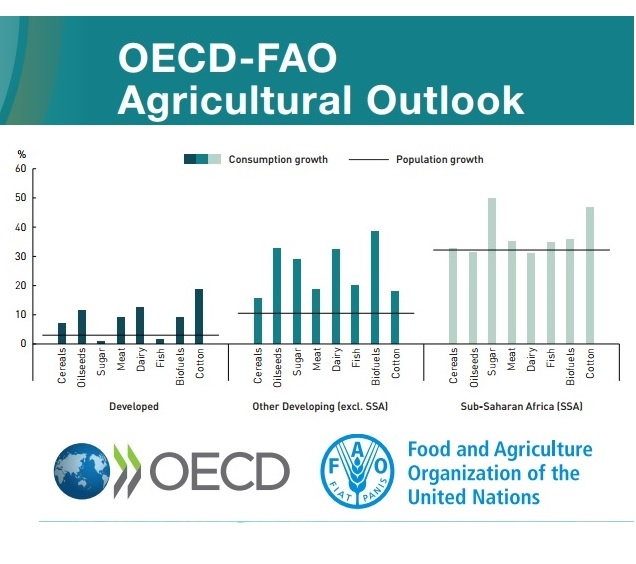OECD-FAO Agricultural Outlook : get free data on supply, demand, trade and price estimates


(A 4-page summary flyer for the OECD-FAO Agricultural Outlook 2016-2025)
The Agricultural Outlook (launched in 2016) is a collaborative effort the Organisation for Economic Co-operation and Development (OECD) and the Food and Agriculture Organization of the United Nations (FAO). It brings together the commodity, policy and country expertise of both organizations and input from collaborating member countries to provide an annual assessment of prospects for the coming decade of national, regional and global agricultural commodity markets.
__________________________________________________________________________________________________
The purpose of Agricultural Outlook website is to bring into the public domain information (on supply, demand, trade and price estimates) used and generated by collaborative work between the OECD and the FAO in the field of agricultural market outlook. The final product of this collaboration is an annual publication presenting projections and related market analysis for some fifteen agricultural products/commodities over a ten year horizon.
# Read for free OECD-FAO Agricultural Outlook 2016-2025: simply visit the iLibrary for an online version or read it in the embedded window. Members of organisations that subscribe to the iLibrary can also download the full publication in PDF format. |
In addition to OECD countries, the market projections in the report cover a large number of other countries and regions including India, China, Brazil and the Russian Federation, as well as Argentina, South Africa and other developing countries.
The special theme chapter of OECD/FAO (2016) "OECD-FAO Agricultural Outlook" edition focuses on the prospects and challenges of the agricultural sector in Sub-Saharan Africa:
# CHAPTER: Agriculture in Sub-Saharan Africa: Prospects and challenges for the next decade: There are more than 950 million people in the Sub-Saharan Africa (SSA) region, approximately 13% of the global population. Despite ongoing transformation of the region’s economies, agriculture remains a crucial sector, providing livelihoods for millions of people...
|
Towards lower prices
Prices for the main crops, livestock and fish products all fell in 2015, signalling that an era of high prices is effectively over for all sub-sectors. Meat prices fell from record highs in 2014, dairy product prices continued declines that started in 2013 and 2014, while crop prices fell further from their peaks in 2012. The main factors behind lower prices have been several years of robust supply growth, weakening demand growth due to the overall economic slowdown, lower oil prices and further accumulation of already abundant stocks...
If historical variations in these factors continue, then there is a strong chance of at least one severe price swing within the next ten years. Such wide inter-annual price movements can mask long-term trends.
Other summary and key findings
- Increases in food demand limited by slowing population growth and a gradual saturation of consumption in emerging economies
- Global undernourishment to decline further, but higher consumption of sugar and fats
- Productivity growth driven mainly by yield improvements
- Global exports to remain highly concentrated and resource poor regions increase food imports
Projections represent fundamental market trends, the underlying assumptions are subject to uncertainties. Climate change may add to this uncertainty, especially if the occurrence of extreme weather events intensifies.
Data Visualisation tool (scroll down this Agricultural Outlook page)
provides you with overview of different commodities (wheat, rice, maize etc.) in different countries (including regions, e.g. EU), according to different variables (production, consumption, stocks, imports, exports).
With Data Visualisation you can also compare different countries on selected commodities as well as global trends (compare a chosen commodity to another one).
# Consult the full user guide to navigate the Agricutural Outlook database |
Source: OECD-FAO Agricultural Outlook website (If you have any technical issues or questions about the site, please contact the Trade and Agriculture Directorate of the OECD).
The Economic and Social Development Department (ES) of the FAO is pleased to announce the following Seminar: The OECD-FAO Agricultural Outlook: 2017-2026 presented by Holger Matthey (Economist, Trade & Markets Division, FAO). Friday, 5 May 2017; 11:00 - 12:30 hrs.; FAO Austria Room (C250bis). All FAO staff are welcome to attend! |

